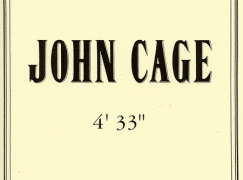Listen: The first performance of John Cage’s 4’33”
mainA BBC Radio 4 documentary.
Listen here.


Rudolph Vrbsky, principal oboist of the National Symphony…

The King has sent a message of support…

Message from the BBC Symphony Orchestra: We regret…

The BBC has parked a new interview with…

Session expired
Please log in again. The login page will open in a new tab. After logging in you can close it and return to this page.
I listen to this every day for hours on end, I wonder how much I owe in royalties…
(Sound of crickets)
I much prefer Danny Kaye’s
“THE KING”S NEW CLOTHES !
There’s more music in this than most things Cage composed!!
https://www.youtube.com/watch?v=TJ9f2rnjB84
I don’t get it – the link forwards to a German review of a very conventional festvial programme.
I once attended a public discussion where John Cage was asked about 4’33”. He briefly explained how this was the logical outcome of his train of thought, bluntly stated that he didn’t have to work on such parameters as pitch or rhythm, and then broke into a hearty laughter. So did the audience.
Apologies. The correct link has been installed.
Thank you Norman.
“about” the first performance, not a record of it at http://www.bbc.co.uk/programmes/articles/b8rCsLSzpCW6cJHKPjCf57/five-seismic-moments-in-new-music
‘There’s no such thing as silence. What they thought was silence, because they didn’t know how to listen, was full of accidental sounds. You could hear the wind stirring outside during the first movement. During the second, raindrops began pattering the roof, and during the third the people themselves made all kinds of interesting sounds as they talked or walked out.’ Nonsense, the sounds were not the piece because there was no piece there. One of those silly ‘ideas’ by and for people who cannot think.
I can’t tell you how many performances I’ve been to of 4’33” where the pianist completely screwed it up, performing for 4’32″ or 4’34”.
People mistakenly think 4’33” can be performed with some sort of device that tells time. That’d be like playing Bach with a metronome.
Just as a drummer must practice to attain perfect rhythm, so the soloist must practice to attain perfect timing.
It’s simple: “1 one-thousand, 2 one-thousand, 3 one-thousand….” and so on until “273 one-thousand”
It’s the only piece where every member of the audience can perform along with the soloist.
“The work may be performed by an instrumentalist or any combination of instrumentalists and last any length of time.”
http://www.bruceduffie.com/cage.html
Nice interview done by Bruce Duffie again for WNIB in Chicago some years ago and been transcribed, and worth a read.
Rather similar to James’ comment above, Cage was once giving a lecture to music students in Lisbon. A well-known Portuguese pianist and Festival organiser told me that during the Q&A one student piped up: “Mr. Cage, I was so impressed with your performance of 4’33” yesterday. Would you be annoyed if I were to write a similar work titled 5’14”?
I would be flattered, responded Cage. “But if I may suggest, write it for violin!”
This aptly demonstrates the level of Cage’s enterprises.
In fact, you’ll often find Cage supporters become infuriated when people ridicule 4’33” because they say he did write serious music. I believe Cage did this all to himself with his ridiculous notions of 4’33”. If it’s the thing people mostly talk about when Cage is mentioned then people who engage in gimmickry need to be careful what they wish for!
I think their annoyance may have more to do with the fact that such people simply aren’t aware of anything else he wrote. Try getting a response from them about his sonatas for prepared piano, his Number pieces, or his settings of texts by Joyce or Cummings. They’ve only ever heard of the “funny, silent piece”.
The Estate of John Cage has sued people using silence in “music” or “sonic art” as infringement of copyright.
In a philosophical sense, Cage has plagiarized the entire silence of the universe.
I take it that the applause at the end was silent!